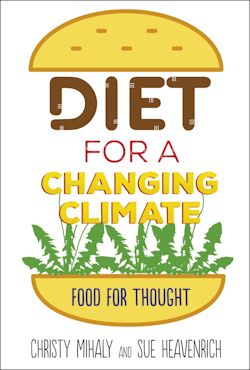SEJournal Online is the digital news magazine of the Society of Environmental Journalists. Learn more about SEJournal Online, including submission, subscription and advertising information.
BookShelf
“Diet for a Changing Climate: Food for Thought”
By Christy Mihaly and Sue Heavenrich
Twenty-First Century Books, $37.32
Reviewed by Christine Heinrichs
 |
Children’s book authors Christy Mihaly and Sue Heavenrich (a long-time environment and science writer) have bonded over bugs.
Their inventive new book combines some features of a cookbook and a guidebook with basic plant, fish, mammal, insect and other invertebrate biology for high school students — and the rest of us.
Its focus on invasive species as food brings a fresh perspective to the serious problems they are causing, whether it’s kudzu in the South, lionfish in the Caribbean, feral pigs digging up the land or Asian carp consuming everything in the water.
Invasives upset ecosystems, crowd out native plants and animals, and sometimes overwhelm systems to create a monoculture that supports little else.
I got my own first cue to the seriousness of invasive weeds a few years ago on a reporter tour sponsored by the Society of Environmental Journalists.
We visited ranches in Montana and, chatting with one of the ranchers, I asked what his worst problem was. I expected him to say, “the federal government” or “the weather.” But he pondered for a moment and said, “Invasive weeds. There’s nothing for my cattle to eat.”
I admit now that one of my fantasies is that someone discovers that thistles or mustard has some valuable quality that attracts people to come and dig them up. Alternatively, I dream of requiring every visitor to our California coastal tourist town to pull invasive weeds for 10 minutes as the price of visiting.
Putting invasives on our plates
Eliminating invasive species may be impossible, but finding some use for them can help control them.
How about eating them?
|
EDITOR’S NOTE: BookShelf is going monthly! The feature, edited by SEJournal Online book editor Tom Henry, will now increase its frequency to bring you more regular reviews of the latest environmental books of interest to journalists. |
Mihaly and Heavenrich are at the forefront of putting invasive plants, fish and other marine critters, land animals such as pigs and iguanas, and insects on our plates.
Not all invasive plants are edible, of course, but Mihaly and Heavenrich make the pitch for the ones that are.
Many recipes are included, explained clearly to make them attractive to young people learning their way around a kitchen.
Expanding beyond plants leads to feral pigs, Asian carp and other fish, and iguanas. Even getting these animals and the problems they cause into public awareness helps broaden perspective, whether or not they show up on any of our tables. Their depredations on ecosystems get attention as local problems, but the damage is all too global.
Bugs are a stretch for me, which is why directing this book to young people is good.
The young are likely to be more adventurous in their food preferences. Crickets, which the authors call the Gateway Bug, could be a fad that takes hold. It’s certainly better than other internet fads, like choking on cinnamon or eating detergent pods.
Climate change is changing everything, including the availability of foods we’ve relied on in the past. Mihaly and Heavenrich are offering possible alternatives. That makes this a good gift book, donation to a classroom or inspiration for a project.
Christine Heinrichs is a longtime SEJ member who writes about wildlife and domestic poultry from her home on the California coast. Her “Backyard Field Guide to Chickens” is a dream book for feathery beauties.
* From the weekly news magazine SEJournal Online, Vol. 3, No. 44. Content from each new issue of SEJournal Online is available to the public via the SEJournal Online main page. Subscribe to the e-newsletter here. And see past issues of the SEJournal archived here.














 Advertisement
Advertisement 



